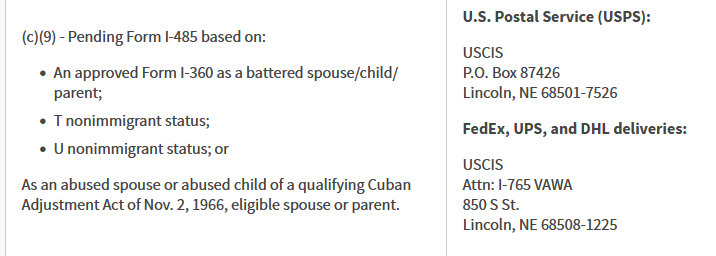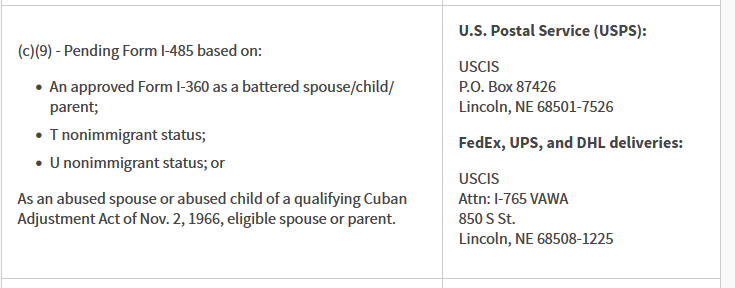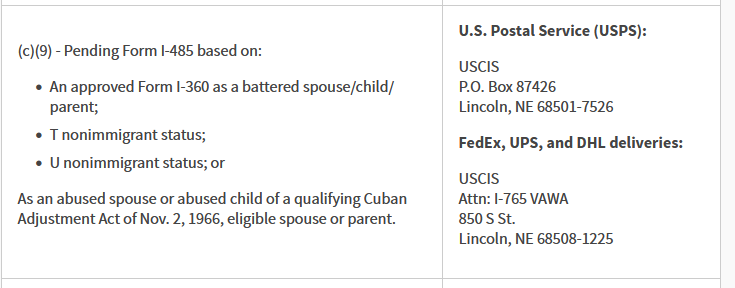-
Posts
1,575 -
Joined
-
Last visited
Content Type
Profiles
Forums
Partners
Immigration Wiki
Guides
Immigration Forms
Times
Gallery
Store
Blogs
Everything posted by Demise
-

VAWA, Part 27
Demise replied to TBoneTX's topic in Effects of Major Family Changes on Immigration Benefits
Do you have a link to the AMA? I swear every time something changes there's always some panicked piece out of some law office that tells you to hire a lawyer. Only official document I could find is a memo from the Carrier Liaison Program: https://www.cbp.gov/sites/default/files/2025-01/executive_order_on_securing_our_borders_20250122.pdf. Like do they have actual examples where this happened or is it just "oh you know, it might happen" similar how tomorrow you could be struck by lightning. Also, in either case, the question was about domestic air travel, so you know, show TSA a driver's license, and that's likely that. -

VAWA, Part 27
Demise replied to TBoneTX's topic in Effects of Major Family Changes on Immigration Benefits
Don't see why not. -
Long story short: Generally no. Generally in order to be eligible for an EAD after filing an I-140, you also need to file I-485 (and the EAD would be based upon a pending I-485 (category (c)(9)), however you are not eligible to file I-485 until EB-2 either "Final action dates" or "dates for filing" chart passes your I-140 priority date (which for an EB-2 NIV would be the date the I-140 was filed, USCIS determines which chart to use and they do vary from month to month). Now, there is the (c)(35) category for E-3/H-1B/H-1B1/L-1/O-1 facing compelling circumstances but I don't believe many of those are granted: https://www.uscis.gov/working-in-the-united-states/information-for-employers-and-employees/employment-authorization-in-compelling-circumstances, also there's the main issue that by using such an EAD you do fall out of status and essentially end up in something akin to deferred action: You can work, are not accruing unlawful presence, but in order to get your green card you'd need to leave US and undergo consular processing. So my main question is: Why exactly do you feel that you need an EAD right now? Are you concerned about something like hitting the 6 year cap on H-1B or something?
-

Will companies failure to amend my TN visa affect future green card?
Demise replied to maplesyrup2022's topic in Work Visas
Yeah you'll be fine. -

Will companies failure to amend my TN visa affect future green card?
Demise replied to maplesyrup2022's topic in Work Visas
Main question how are you adjusting via your husband? Is he a citizen and you're adjusting via marriage, or is he adjusting by work and you're tagging along? In either case it shouldn't be a factor. We can definitely debate whether working the wrong job for the correct employer on TN is a status violation, however in the former case it's not a factor, in the latter case 245(k) would cover you. Only circumstance where it's worth digging deeper into the specific case law would be if hubby's a permanent resident and you're seeking to adjust an F-2A. Though worst case scenario in case like this you'd just need to do consular processing (go pick up the visa in Canada rather than adjust in US). -
Congress can barely pass a budget these days, which is one of the few things that can get through with a simple majority in the senate. I do not expect an amendment like this to get far.
-
I doubt it'd hold up in court. US v. Wong Kim Ark (1898) listed the few exceptions to the 14th amendment (born to foreign diplomats, born to hostile foreign soldiers, born to native tribes, born on foreign ships in US waters). Birthright citizenship (at least for white people) was also the law on the books in many states since national citizenship wasn't exactly a thing prior to the 14th amendment (congress had the power to institute a uniform rule of naturalization, but the implementation was up to the states). Wong happened after the Chinese Exclusion Act and while his parents were grandfathered due to coming to US prior to the act's passage, illegal immigration happens basically as long as there's any kind of immigration controls and there likely were at least some Chinese people who stowed away on ships or entered with fake papers and the court failed to exclude their children from citizenship in the opinion. Hinging it all on "and subject to jurisdiction thereof" would also have a comical outcome if you were to claim that undocumented immigrants aren't bound by US law and enjoy basically diplomatic immunity. Like I don't expect any of the appellate courts to rule that this EO is any good, I don't expect the Supreme Court to take it up unless there's a circuit split, I don't expect the Supreme Court to not strike it down if it does.
-
Own up to it and your partner will be fine. 245(k) covers cases like this for employment-based adjustment of status: Essentially it allows one to adjust as long as they didn't violate their status for more than 180 days since last entry and essentially wipes out prior overstays as long as they don't add up to a re-entry ban (180+ day overstay).
-
In either case I don't think this will be a problem even if they don't believe you that they took the green card. Generally USCIS wants a valid green card so you don't weasel out of paying for a renewal by instead naturalizing. So generally they will want either a valid green card or an I-90 receipt notice. I see no reason why I-751 notice wouldn't work as proof that you paid the man.
- 11 replies
-
- n400
- oathceremony
-
(and 2 more)
Tagged with:
-
In a case like this either you'd need to correct the birth certificate to match her legal name, or you might be better off just getting a DNA test instead. USCIS is picky with the labs it does accredite and the list of those can be found here: https://www.aabb.org/standards-accreditation/accreditation/accredited-facilities/aabb-accredited-relationship-testing-facilities If mother's in Zimbabwe then the closest one is in Kampala, Uganda. You might be able to chance it with affidavits explaining the name mismatch but in case like this they'll likely just want a DNA test since USCIS isn't exactly the most understanding for African countries.
-

FOIA request
Demise replied to Ani2's topic in Adjustment of Status from Work, Student, & Tourist Visas
FOIA not really, it will show the forms and might reveal some internal worksheets and some scribbles on margins but that's about it. You won't find anything interesting in there, a lot of the more fun stuff will be fully redacted out. Like being 5 months since she filed it's basically just sit down and wait, I-485 will likely take 12-18 months. If she's antsy about the ability to work then it might be better to have a senator or congressman inquire on the status of the I-765 (she did file that one, right?), that can end up with it being approved since the inquiry requires someone to pull it out of the stack, and if they pull it out then they might as well just approve it here and now. -

VAWA, Part 27
Demise replied to TBoneTX's topic in Effects of Major Family Changes on Immigration Benefits
Medicals - yes, you have to send them in. I-864W - I just checked and you are completely right, I-864W is no longer required. -
That response is correct. Your lawyer messed up and is quite frankly an idiot. C31 can only be granted based upon an approved I-360 but that is not the only category you're eligible to seek an EAD under. If you have a pending I-485 (either filed with I-360 or you transferred the one from the I-130 to I-360) then you should instead file I-765 under category code (c)(9). That one is based solely on pending I-485 and doesn't need the I-360 or anything else to be approved first. If this a new I-485 then the I-765 should be an initial application, if it's an old I-485 transferred from I-130 then the I-765 should be a renewal application. If you do not have a pending I-485 then file one based on the pending I-360 and include the I-765. If the I-485 from the I-130 is still pending and wasn't transferred to the I-360 then you should write to the office that has it requesting a transfer of underlying basis to the I-360 (include a receipt notice), and then file I-765 (c)(9) based on that I-485. If you are for some reason unable to file I-485 (e.g. final order, or you entered on K-1 and the abusive spouse you are claiming VAWA protections from is not the one who got you the K-1) then you should instead file I-765 based on category (c)(14) and I-765WS and instead request that they give you a prima facie. Prima facie determination comes with a supplemental grant of deferred action which makes you eligible for an EAD under category (c)(14). All the VAWA associated forms (I-360, I-485, I-765 (c9, c31, c14), I-131, associated waivers, etc) do not require a fee and are free to file.
-

CSPA Age
Demise replied to valkyri3's topic in Bringing Family Members of Permanent Residents to America
You'll need to contact NVC. They very frequently will just go by actual age in the early stages of the process. Anyways doing the math: DOB: 3/23/2001 I-130 filed: 6/6/2021 I-130 approved: 8/28/2024 Age at filing: 20 years, 2 months, 14 days. Time I-130 was pending: 1180 days Priority date was current on the date the I-130 was approved, so that's the visa availability date and CSPA age is currently frozen at 20yrs 2mos 14 days. So you/your kid have until August 28, 2025 to file DS-260/I-485/I-824 to lock in the age. Also, you shouldn't naturalize until after the kid is in US. Age at parent's naturalization overwrites normal CSPA age so that'd drop them into F1. Similarly they shouldn't marry until they're in US because marriage would kill such a petition. -

VAWA, Part 27
Demise replied to TBoneTX's topic in Effects of Major Family Changes on Immigration Benefits
Listen, USCIS says to file with Nebraska so you probably should file with Nebraska. You can likely chance it and file with Vermont but there's a chance that they'll just send it back. They definitely won't send it back if you follow the actual directions, finally I-765 receipt notice provides an automatic extension (540 days?) to the old EAD, so you shouldn't care when it's approved (which I guess filing with Vermont is trying to accomplish), only that it gets there before the old one expires. In my own case I-360 was filed with and approved by Vermont. (Had admin closed removal proceedings so couldn't concurrently file). Then they changed the mailing location, I filed my I-485, I-765, and I-131 with Nebraska. Nebraska accepted the filing and later forwarded it to Vermont which approved the I-765 and I-131 and passed the I-485 to the NBC. So can you try playing lose with what it says? Meh, probably. Should you? Nah. $0. Recent changes to the fee schedule made VAWA I-485, I-765, and I-131 all free. VAWA I-360 was always free as far as I can tell. Also he shouldn't forget the medicals, another recent change will make USCIS reject any I-485 filed without medicals. Also he shouldn't forget the I-864W. -

VAWA, Part 27
Demise replied to TBoneTX's topic in Effects of Major Family Changes on Immigration Benefits
Nebraska: They changed the mailing location sometime in mid 2023 around the time when I filed my AOS. -

VAWA, Part 27
Demise replied to TBoneTX's topic in Effects of Major Family Changes on Immigration Benefits
Policy changes generally aren't retroactive because that's just a pile of lawsuits waiting to happen. Also yes, if they issued you an I-485 receipt notice then they have accepted your application. Like the policy is that they're reject any new filing missing the medicals, not that they'll deny those who filed without medicals previously. So it used to be this way: If you paid for I-485 then I-765 renewals were free. If you got a fee waiver for I-485 then you'd either need to pay for I-765 renewals or submit another fee waiver. C31 renewals they wanted you to pay for or get a fee waiver. Currently VAWA I-485, I-765 (C09 and C31), I-131, and some other forms are just blanket free regardless of when the case started or your ability to pay. You do not need to pay nor do you need to submit a fee waiver request. For C31 renewal you need to include a copy of the I-360 approval notice and ideally a copy front and back of your current C31 EAD. -

VAWA, Part 27
Demise replied to TBoneTX's topic in Effects of Major Family Changes on Immigration Benefits
https://www.uscis.gov/g-1055?form=i-765 Yep. C09s for VAWAs and C31s are free these days. This includes initial, renewal, and replacement applications. -

VAWA, Part 27
Demise replied to TBoneTX's topic in Effects of Major Family Changes on Immigration Benefits
Yeah same address. One thing of note is that recent changes to free schedule made I-485, I-765, I-131, and other similar forms free for VAWA filers. Currently both C9 (based upon VAWA I-485) and C31 are free. -

VAWA, Part 27
Demise replied to TBoneTX's topic in Effects of Major Family Changes on Immigration Benefits
If they took your I-485 filing then they'll RFE you for it or send you a courtesy notice to bring it to you to an interview. (Note that getting an RFE is a good indication that they might waive the interview that's not absolute, I got RFE'd for medicals and then interviewed regardless, though in my case I had an EWI and prior removal proceedings). Right now they will reject a filing without the medicals - not deny, reject, they will take your whole filing, put it in an envelope, and mail it back to you. It's I-765. I-751 is a different form (removal of conditions for permanent residence) Do you need a C31? If you have a C9 EAD then just use that one and renew it as needed. If you don't have a C9 you can file the initial for that at the same time as C31 renewal. Reason for this is two-fold: C9 is valid for 5 years, C31 does get automatic extensions when you file a renewal, so a renewal would bridge any gap. If you want the C31 just because (peace of mind, fallback in case you lose the C9, etc) then you can file a renewal and don't let me stop you. These (all VAWA EADs) go to For USPS: USCIS P.O. Box 87426 Lincoln, NE 68501-7526 For FedEx/UPS/etc: USCIS Attn: I-765 VAWA 850 S St. Lincoln, NE 68508-1225 -
She's eligible to either naturalize under either: LPR for 3 years, married to a US citizen provision LPR for 5 years provision Prices are the same. Generally the 5 year provision is the simpler one because the 3 year one requires you to once again provide the bona fides of the marriage. Also keep in mind that USCIS interviews for every single naturalization application (because they have to give the applicant the whole test) so they can and will switch the basis when the case warrants it. So unless there's some breaks in residence that could prevent her from using the 5 year one, normally in a case like this even if she were to tick the 3 year option they'd likely just switch it to the 5 year option so they don't have to look at the marriage stuff yet again.
-

VAWA, Part 27
Demise replied to TBoneTX's topic in Effects of Major Family Changes on Immigration Benefits
I mean the I-360 is the hardest part. Unless you have some issues of admissibility it should be relatively smooth sailing from here. -

VAWA, Part 27
Demise replied to TBoneTX's topic in Effects of Major Family Changes on Immigration Benefits
Looking at your case you filed I-360 and I-485 and are not in removal proceedings so send it to: Not sure why you sent it to Illinois nor why they sent it to Vermont who then rejected it instead of passing onto Nebraska. VAWA stuff generally goes straight to the service center. USCIS has roughly a year ago started using Nebraska as the submission location for VAWA forms then they either hang onto it or pass it to Vermont.








